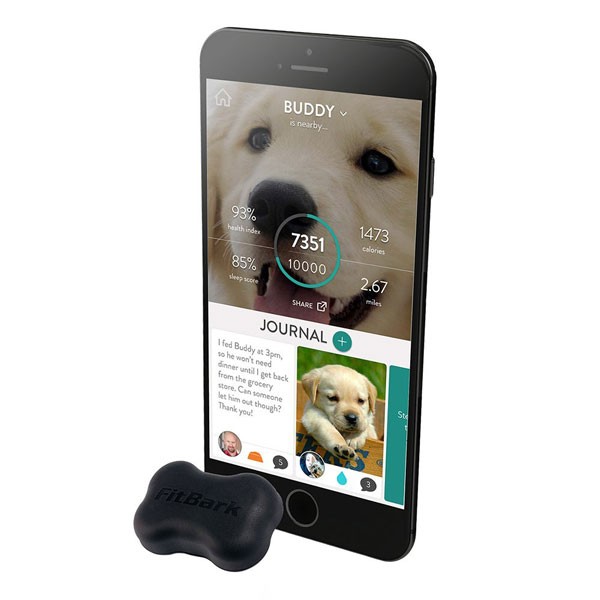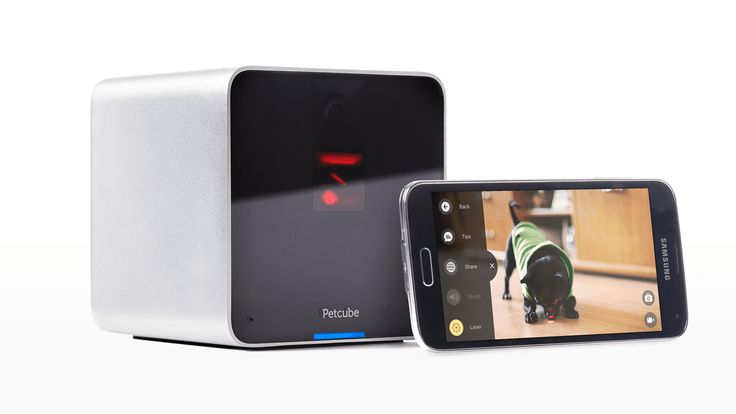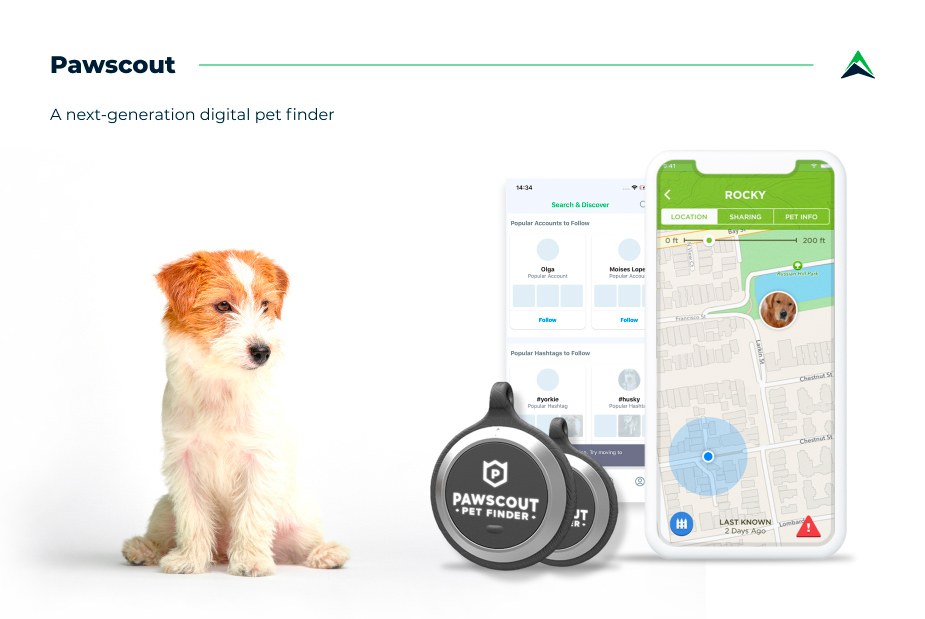The article was updated on December 14, 2022.
People won’t spare any money when it comes to their pets’ happiness, health, and well-being. Indeed, our domestic little friends deserve all the love and attention we can give them, which includes the newest IoT pet technologies on the market. No wonder smart pet tech solutions have been growing in demand over the years. After all, people rely on technology in most spheres of their lives, not making pet care an exception.
Thus, last year the IoT pet products market was already worth $5.7Bn, expecting to show an annual growth rate of 17.90% till the end of the decade. Considering what a relatively new tech area this is, the growth is impressive. Overall, the pet tech market’s worth in 2030 is predicted to be about $24.72Bn and it’s easy to see why. The new IoT solutions for pets can offer a lot of unique services.
For example, these smart devices can help people monitor their dogs’ and cats’ locations and behavior, keep track of their health, assist in training, analyze their activity levels, and so much more. So, let’s explore what business opportunities this new, expanding market has to offer.
In this article, we will analyze what the pet tech market is, what it offers to users and businesses, how to enter this niche, and steps to take when building pet IoT apps from scratch.
Pet care IoT application opportunities for business
The demand for better pet care solutions is constantly growing. Several factors contribute to such a tendency. For one, more people own pets these days, often more than one, too. Such statistics are also linked to the global pandemic and lockdowns, where people found companionship in their pets.
Secondly, the expected level of pet care is also increasing. Animal healthcare has progressed drastically over recent years, while governments enhanced their control over proper pet management.
Also, with the rising popularity of IoT solutions, smart IoT devices for pets become an essential part of any household with animals. These pet products can make people’s lives much easier, providing them with all the necessary information and help with their furry, scaly, or even feathery friends.
Thus, the need for smart IoT devices for pets is growing due to the increasing number of households with pets worldwide along with their higher pet care expectations. It seems that smart technologies for the pet industry are among the leading IoT development areas. Surely, such an emerging market leaves numerous possibilities for businesses.
For example, the wearable market alone is expected to face a 14.3% annual growth rate in the next eight years. Just last year, this market’s estimated size value was at $2.07Bn.
Though, in general, the American Pet Product Association expects US pet owners to spend over $100Bn on their animals by the end of this year. These numbers alone demonstrate how much people are ready to spend on their domestic companions, and how much they have begun to rely on smart pet tech solutions. Not to mention those businesses that are ready to tap into this emerging market will enjoy a lot of opportunities with little competition.
Popular examples of IoT applications for pet care
The Internet of Things for pets offers numerous possibilities for keeping animals and their owners well and happy. These applications aim at improving the level of understanding, indirect communication, and overall interactions between people and their pets.
Broadly speaking, all IoT applications for pets are divided into two categories. These are the things pets can wear or items that pets or pet owners often use. So, let’s see what products relate to both these categories.

Wearable pet devices
Pet wearable devices come in a great variety of types, forms, and purposes. Overall, the demand for such devices is on the rise, as they help monitor pets’ safety and well-being. Let’s see the main areas where wearable IoT devices for pets are most suitable.
1. Location positioning
The logic behind location positioning smart devices is rather simple. An IoT dog collar with a locator beacon can prevent any bad incidents where your pet runs loose or gets lost on a walk. Thus, whenever an owner loses a pet, or when the pet is simply out of their sight, an IoT application with GPS technology can instantly show them the way.
An owner will be able to see their pet’s beacon in real time to locate and find their loving friend. Such a device surely grants higher security for pets, while putting their owners at ease in case anything happens.
2. Identification
Smart pet tags can help owners identify their pets and find their whereabouts. Thus, in the case of having many pets in the household or livestock on the farm, owners can use IoT identification for easy access to animals’ activities.
Example: Dynotag.
3. Health/activity monitors
Just like human devices, smart collars and wearable tags can be used to keep track of your pet’s wellbeing. Equipped with various sensors including temperature, heart rate and respiration, activity and calorie intake, they can provide comprehensive information on the spot, 24/7. Thus, as soon as there is any change in your pet’s health, you will be able to see it immediately and take the required actions.
Such devices can also track your pets’ activity during the day and even measure the duration and quality of their sleep.
In addition, a pet health monitor can also be used for tracking the health of livestock, such as horses, cattle, and other large domestic animals.
Lastly, these pet applications may also help during training for sports competitions. Now owners can see their pets’ reaction to training and adjust the stimulation/rest periods accordingly.
Example: FitBark

4. Behavior monitoring
Smart technology can monitor pets’ behavior, analyze it and help owners make the proper adjustments. Thus, IoT pet tracking devices can also help owners observe pets’ eating habits, activity levels, and movement around the house.
Hence, such devices can be essential in better understanding and correcting pets’ behavior, even when owners are not at home with their pets.
Example: Animo.
Connected pet products
The other category of smart pet care devices focuses on connecting pets with their owners and surroundings. It includes various toys, home devices, home sensors, and other smart technology places throughout the house.
Such items provide the following solutions:
1. Smart feeders
In addition to being able to effortlessly schedule your pet’s feeding, these devices are constantly connected to your mobile device. Thus, you get notifications when your pet had lunch, including the amount eaten. You can manage the time and portion sizes remotely.
However, it is important that the feeder does not rely completely on the connection. It should be autonomous, so in case of a blackout or poor Internet connection, your pet won’t be left without food.
Some of the feeders can integrate seamlessly into smart home systems or work with digital assistants, such as Amazon’s Alexa.
Example: Petnet

2. Pet entertainment
Most pets get naughty only when they are bored. It’s no wonder that leaving a pet alone at home for the entire day will force them to seek entertainment for themselves. Of course, rarely such entertainment will be to the owners’ liking. Fortunately, smart technologies for pets offer great help in keeping animals happy and engaged.
For example, such technology can activate pet toys, or other devices in a house, like a TV, once an owner is away. People can either use home sensors to use direct signals to smart devices or activate gadgets on their smartphones at any moment.
3. Pet monitors and interactive cameras
Similar to radio-nanny, pet monitors can help you plug in and see how your pet is doing while you are away. You can also talk to your furry friend, dispense treats, or interact with your pet, right from your mobile device.
Example: Petcube

4. Security protection
Owners who choose to keep their pets in a puppy pen or crate can add an extra protection level with smart pet technologies. This technology can monitor pets’ behavior in their protected area, lock the crate, so no one without the application can open it, and automatically open the gate when necessary.
In addition, the IoT sensors can pick up on any unusual activity and send notifications. So, owners will know when their pets are overly active or suspiciously calm.
Example: PetChatz.
5. Pet hygiene
Domesticating pets can be quite a challenge for new owners. Fortunately, with a little bit of help from software products for pets, one can go through this process with less damage and less stress. Such technology can track pets’ habits and movements, helping them understand their toilet habits.
Plus, extra humidity and temperature sensors around the house may inform you when and where you may find an unwelcome surprise.
Example: FitBark.
There are many more opportunities for IoT technologies in the pet care market (there’s even a smart litter box!). Regardless of the approach you choose, it’s the execution that really matters after all. That is why it is important to understand the main steps required to develop an IoT app for pets.

How to build an IoT application for pet care? The main aspects you should take into account
As with any other IoT application development project, building an app is only one part of the project. Namely, to build a full-fledged IoT product, you need to consider the following aspects:
- Hardware platform (i.e. your processing board, and microcontrollers). This is the device itself. Be it a custom design or a solution built on top of the available platforms (e.g. Arduino or Raspberry Pi), the choice should depend solely on the purpose of the device and required functionality.
- Backend and networking. Establishing a solid backend infrastructure is one of the essential elements of a successful IoT product. Working in real time with large amounts of data, you need to be sure that connection is reliable and can handle the load. Security should be built into your product by default.
- Integrated mobile app. It is the only part of your product that users will directly interact with. Thus, you need to make it intuitive and user-friendly (We will get to the functionality later).
- APIs. To tie the hardware, backend, and mobile app into one system (or connect to any third-party system or service), you need reliable bridges between the three elements.
- Data storage and analytics. The brain of your product, data storage and analytics are essential for building a truly intelligent solution. This will help you make sense of the loads of data the sensors will collect, as well as introduce personalization capabilities later on.
What makes a good Pet-Tech app? Core features to add to your pet care IoT app
Depending on the purpose of your device and its functionality, IoT apps for pet care can include the following features:
- A personal account
This should include basic info about the pet, preferably easy to customize: the type of pet, its breed, age, weight, name, any health information (chronic conditions, appropriate food/water rations, activity goal, etc.). It’s worth taking into account that a social login is usually not an option for creating pet profiles (unless you want to add an owner page to the app).
- A real-time dashboard
This should be the main page of your app. It allows you to see the current state of the pet, i.e. temperature, pulse, activity level, time till next feeding or walk, etc. For an interactive monitor or feeder device, the real-time video stream of your pets and options to feed/play with them could be placed on the main screen.
- History and trends overview
This page could include the health and activity logs (grouped by days, weeks, months, etc.), and feeding or sleep patterns. It would be a great idea to add tailored recommendations or relevant health tips to this screen to help users make more sense of the raw data.
- GPS tracking (for wearables)
This feature makes it possible to know where your pet is located at all times. Users can set “safe zones”, so the alert is triggered as soon as the pet leaves the permitted area. As in Pawscout, once a pet is lost, the app can send out notifications to all the users nearby so they can help you find it.
- Interactive elements (for non-wearable treat dispensers, and toys)
From this screen, users can connect to the device and control it remotely, interacting with the pet, playing or giving treats, etc.
Our work cases of IoT solutions for pets
Let’s see some of the IoT pet products created at Eastern Peak for our clients.
Pawscout
We have worked on the Pawscout Pet Finder – a smart pet tag that comes with GPS and BLE trackers. Pet owners can connect to the tracker via an application and instantly locate the animal.
The trackers work within a 200-foot radius. Plus, a user will receive a notification if a pet crosses the designated borders. Thus, it also has a function of a ‘virtual leash.’ This tracking device is designed to keep an animal safe, while also creating a global online community for pet owners.

Create your pet technology products with the Eastern Peak team
The potential for the IoT pet technologies market is limitless. As long as people care for their pets and wish to make their lives a little easier, pet tech will stay in high demand. So, if you’ve ever considered entering the pet market, it’s a perfect time.
How to get started?
The product discovery phase is the best first step you can take to lay a solid foundation for the development of your app. It includes a functional specification, UX/UI design, and a visual prototype that will give you a clear vision of the end product. On average, this phase takes 4-6 weeks.
The product discovery phase can help you:
- define a full scope of work and develop a roadmap for the project
- set a realistic budget for your MVP and plan your resources
- test the waters with your audience using a visual prototype
- craft a convincing investment pitch
- get to know your team
On our behalf, having plenty of experience in pet smart app development, we, at Eastern Peak, are ready to provide you with all the necessary information on how to start.
So, contact us now for a free consultation with our team to discuss your ideas and map out your next steps.
Read also:



